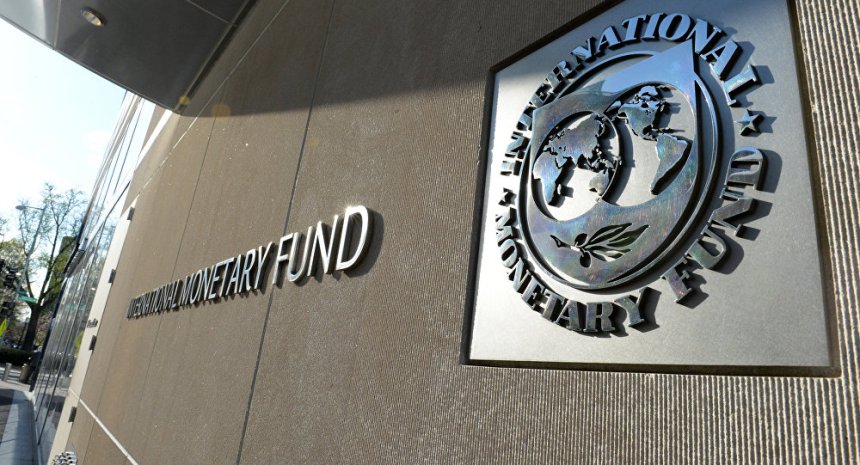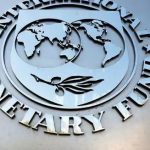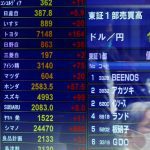The International Monetary Fund has said it expects inflation in Nigeria and Angola to remain elevated at two-digit levels next year.
The IMF said this would reflect the persistent effects of past inflationary shocks coming from sharp currency depreciation as well as higher electricity and fuel prices and, “in the case of Nigeria, reflecting the assumption that monetary policy will remain accommodating going forward.” Inflation in Nigeria dropped marginally from 16.1 per cent in June to 16.05 per cent in July, the sixth consecutive decline in the rate since January 2017, according to the National Bureau of Statistics.
Inflation in Nigeria dropped marginally from 16.1 per cent in June to 16.05 per cent in July, the sixth consecutive decline in the rate since January 2017, according to the National Bureau of Statistics.
It noted that the latest World Economic Outlook report had upgraded its global growth projections to 3.6 per cent for this year and 3.7 per cent for next year, well above 2016’s global growth rate of 3.2 per cent, which was the lowest since the global financial crisis.
“Economic growth in sub-Saharan Africa is projected to reach 2.6 per cent in 2017 and 3.4 per cent in 2018 (broadly in line with the April forecast), with sizable differences across countries,” it said.
The IMF said downside risks had risen because of idiosyncratic factors in the region’s largest economies and delays in implementing policy adjustments.
“Beyond the near term, growth is expected to rise gradually, but barely above population growth, as large consolidation needs weigh on public spending,” it added.
According to the report, growth in 2017 is projected at 0.8 per cent, owing to recovering oil production and ongoing strength in the agricultural sector.
“However, concerns about policy implementation, market segmentation in a foreign exchange market that remains dependent on central bank interventions (despite initial steps to liberalize the foreign exchange market), and banking system fragilities are expected to weigh on activity in the medium term,” it said.
The International Monetary Fund has said it expects inflation in Nigeria and Angola to remain elevated at two-digit levels next year.
The IMF said this would reflect the persistent effects of past inflationary shocks coming from sharp currency depreciation as well as higher electricity and fuel prices and, “in the case of Nigeria, reflecting the assumption that monetary policy will remain accommodating going forward.” Inflation in Nigeria dropped marginally from 16.1 per cent in June to 16.05 per cent in July, the sixth consecutive decline in the rate since January 2017, according to the National Bureau of Statistics.
Inflation in Nigeria dropped marginally from 16.1 per cent in June to 16.05 per cent in July, the sixth consecutive decline in the rate since January 2017, according to the National Bureau of Statistics.
It noted that the latest World Economic Outlook report had upgraded its global growth projections to 3.6 per cent for this year and 3.7 per cent for next year, well above 2016’s global growth rate of 3.2 per cent, which was the lowest since the global financial crisis.
“Economic growth in sub-Saharan Africa is projected to reach 2.6 per cent in 2017 and 3.4 per cent in 2018 (broadly in line with the April forecast), with sizable differences across countries,” it said.
The IMF said downside risks had risen because of idiosyncratic factors in the region’s largest economies and delays in implementing policy adjustments.
“Beyond the near term, growth is expected to rise gradually, but barely above population growth, as large consolidation needs weigh on public spending,” it added.
According to the report, growth in 2017 is projected at 0.8 per cent, owing to recovering oil production and ongoing strength in the agricultural sector.
“However, concerns about policy implementation, market segmentation in a foreign exchange market that remains dependent on central bank interventions (despite initial steps to liberalize the foreign exchange market), and banking system fragilities are expected to weigh on activity in the medium term,” it said.
The International Monetary Fund has said it expects inflation in Nigeria and Angola to remain elevated at two-digit levels next year.
The IMF said this would reflect the persistent effects of past inflationary shocks coming from sharp currency depreciation as well as higher electricity and fuel prices and, “in the case of Nigeria, reflecting the assumption that monetary policy will remain accommodating going forward.” Inflation in Nigeria dropped marginally from 16.1 per cent in June to 16.05 per cent in July, the sixth consecutive decline in the rate since January 2017, according to the National Bureau of Statistics.
Inflation in Nigeria dropped marginally from 16.1 per cent in June to 16.05 per cent in July, the sixth consecutive decline in the rate since January 2017, according to the National Bureau of Statistics.
It noted that the latest World Economic Outlook report had upgraded its global growth projections to 3.6 per cent for this year and 3.7 per cent for next year, well above 2016’s global growth rate of 3.2 per cent, which was the lowest since the global financial crisis.
“Economic growth in sub-Saharan Africa is projected to reach 2.6 per cent in 2017 and 3.4 per cent in 2018 (broadly in line with the April forecast), with sizable differences across countries,” it said.
The IMF said downside risks had risen because of idiosyncratic factors in the region’s largest economies and delays in implementing policy adjustments.
“Beyond the near term, growth is expected to rise gradually, but barely above population growth, as large consolidation needs weigh on public spending,” it added.
According to the report, growth in 2017 is projected at 0.8 per cent, owing to recovering oil production and ongoing strength in the agricultural sector.
“However, concerns about policy implementation, market segmentation in a foreign exchange market that remains dependent on central bank interventions (despite initial steps to liberalize the foreign exchange market), and banking system fragilities are expected to weigh on activity in the medium term,” it said.
The International Monetary Fund has said it expects inflation in Nigeria and Angola to remain elevated at two-digit levels next year.
The IMF said this would reflect the persistent effects of past inflationary shocks coming from sharp currency depreciation as well as higher electricity and fuel prices and, “in the case of Nigeria, reflecting the assumption that monetary policy will remain accommodating going forward.” Inflation in Nigeria dropped marginally from 16.1 per cent in June to 16.05 per cent in July, the sixth consecutive decline in the rate since January 2017, according to the National Bureau of Statistics.
Inflation in Nigeria dropped marginally from 16.1 per cent in June to 16.05 per cent in July, the sixth consecutive decline in the rate since January 2017, according to the National Bureau of Statistics.
It noted that the latest World Economic Outlook report had upgraded its global growth projections to 3.6 per cent for this year and 3.7 per cent for next year, well above 2016’s global growth rate of 3.2 per cent, which was the lowest since the global financial crisis.
“Economic growth in sub-Saharan Africa is projected to reach 2.6 per cent in 2017 and 3.4 per cent in 2018 (broadly in line with the April forecast), with sizable differences across countries,” it said.
The IMF said downside risks had risen because of idiosyncratic factors in the region’s largest economies and delays in implementing policy adjustments.
“Beyond the near term, growth is expected to rise gradually, but barely above population growth, as large consolidation needs weigh on public spending,” it added.
According to the report, growth in 2017 is projected at 0.8 per cent, owing to recovering oil production and ongoing strength in the agricultural sector.
“However, concerns about policy implementation, market segmentation in a foreign exchange market that remains dependent on central bank interventions (despite initial steps to liberalize the foreign exchange market), and banking system fragilities are expected to weigh on activity in the medium term,” it said.
The International Monetary Fund has said it expects inflation in Nigeria and Angola to remain elevated at two-digit levels next year.
The IMF said this would reflect the persistent effects of past inflationary shocks coming from sharp currency depreciation as well as higher electricity and fuel prices and, “in the case of Nigeria, reflecting the assumption that monetary policy will remain accommodating going forward.” Inflation in Nigeria dropped marginally from 16.1 per cent in June to 16.05 per cent in July, the sixth consecutive decline in the rate since January 2017, according to the National Bureau of Statistics.
Inflation in Nigeria dropped marginally from 16.1 per cent in June to 16.05 per cent in July, the sixth consecutive decline in the rate since January 2017, according to the National Bureau of Statistics.
It noted that the latest World Economic Outlook report had upgraded its global growth projections to 3.6 per cent for this year and 3.7 per cent for next year, well above 2016’s global growth rate of 3.2 per cent, which was the lowest since the global financial crisis.
“Economic growth in sub-Saharan Africa is projected to reach 2.6 per cent in 2017 and 3.4 per cent in 2018 (broadly in line with the April forecast), with sizable differences across countries,” it said.
The IMF said downside risks had risen because of idiosyncratic factors in the region’s largest economies and delays in implementing policy adjustments.
“Beyond the near term, growth is expected to rise gradually, but barely above population growth, as large consolidation needs weigh on public spending,” it added.
According to the report, growth in 2017 is projected at 0.8 per cent, owing to recovering oil production and ongoing strength in the agricultural sector.
“However, concerns about policy implementation, market segmentation in a foreign exchange market that remains dependent on central bank interventions (despite initial steps to liberalize the foreign exchange market), and banking system fragilities are expected to weigh on activity in the medium term,” it said.
The International Monetary Fund has said it expects inflation in Nigeria and Angola to remain elevated at two-digit levels next year.
The IMF said this would reflect the persistent effects of past inflationary shocks coming from sharp currency depreciation as well as higher electricity and fuel prices and, “in the case of Nigeria, reflecting the assumption that monetary policy will remain accommodating going forward.” Inflation in Nigeria dropped marginally from 16.1 per cent in June to 16.05 per cent in July, the sixth consecutive decline in the rate since January 2017, according to the National Bureau of Statistics.
Inflation in Nigeria dropped marginally from 16.1 per cent in June to 16.05 per cent in July, the sixth consecutive decline in the rate since January 2017, according to the National Bureau of Statistics.
It noted that the latest World Economic Outlook report had upgraded its global growth projections to 3.6 per cent for this year and 3.7 per cent for next year, well above 2016’s global growth rate of 3.2 per cent, which was the lowest since the global financial crisis.
“Economic growth in sub-Saharan Africa is projected to reach 2.6 per cent in 2017 and 3.4 per cent in 2018 (broadly in line with the April forecast), with sizable differences across countries,” it said.
The IMF said downside risks had risen because of idiosyncratic factors in the region’s largest economies and delays in implementing policy adjustments.
“Beyond the near term, growth is expected to rise gradually, but barely above population growth, as large consolidation needs weigh on public spending,” it added.
According to the report, growth in 2017 is projected at 0.8 per cent, owing to recovering oil production and ongoing strength in the agricultural sector.
“However, concerns about policy implementation, market segmentation in a foreign exchange market that remains dependent on central bank interventions (despite initial steps to liberalize the foreign exchange market), and banking system fragilities are expected to weigh on activity in the medium term,” it said.
The International Monetary Fund has said it expects inflation in Nigeria and Angola to remain elevated at two-digit levels next year.
The IMF said this would reflect the persistent effects of past inflationary shocks coming from sharp currency depreciation as well as higher electricity and fuel prices and, “in the case of Nigeria, reflecting the assumption that monetary policy will remain accommodating going forward.” Inflation in Nigeria dropped marginally from 16.1 per cent in June to 16.05 per cent in July, the sixth consecutive decline in the rate since January 2017, according to the National Bureau of Statistics.
Inflation in Nigeria dropped marginally from 16.1 per cent in June to 16.05 per cent in July, the sixth consecutive decline in the rate since January 2017, according to the National Bureau of Statistics.
It noted that the latest World Economic Outlook report had upgraded its global growth projections to 3.6 per cent for this year and 3.7 per cent for next year, well above 2016’s global growth rate of 3.2 per cent, which was the lowest since the global financial crisis.
“Economic growth in sub-Saharan Africa is projected to reach 2.6 per cent in 2017 and 3.4 per cent in 2018 (broadly in line with the April forecast), with sizable differences across countries,” it said.
The IMF said downside risks had risen because of idiosyncratic factors in the region’s largest economies and delays in implementing policy adjustments.
“Beyond the near term, growth is expected to rise gradually, but barely above population growth, as large consolidation needs weigh on public spending,” it added.
According to the report, growth in 2017 is projected at 0.8 per cent, owing to recovering oil production and ongoing strength in the agricultural sector.
“However, concerns about policy implementation, market segmentation in a foreign exchange market that remains dependent on central bank interventions (despite initial steps to liberalize the foreign exchange market), and banking system fragilities are expected to weigh on activity in the medium term,” it said.
The International Monetary Fund has said it expects inflation in Nigeria and Angola to remain elevated at two-digit levels next year.
The IMF said this would reflect the persistent effects of past inflationary shocks coming from sharp currency depreciation as well as higher electricity and fuel prices and, “in the case of Nigeria, reflecting the assumption that monetary policy will remain accommodating going forward.” Inflation in Nigeria dropped marginally from 16.1 per cent in June to 16.05 per cent in July, the sixth consecutive decline in the rate since January 2017, according to the National Bureau of Statistics.
Inflation in Nigeria dropped marginally from 16.1 per cent in June to 16.05 per cent in July, the sixth consecutive decline in the rate since January 2017, according to the National Bureau of Statistics.
It noted that the latest World Economic Outlook report had upgraded its global growth projections to 3.6 per cent for this year and 3.7 per cent for next year, well above 2016’s global growth rate of 3.2 per cent, which was the lowest since the global financial crisis.
“Economic growth in sub-Saharan Africa is projected to reach 2.6 per cent in 2017 and 3.4 per cent in 2018 (broadly in line with the April forecast), with sizable differences across countries,” it said.
The IMF said downside risks had risen because of idiosyncratic factors in the region’s largest economies and delays in implementing policy adjustments.
“Beyond the near term, growth is expected to rise gradually, but barely above population growth, as large consolidation needs weigh on public spending,” it added.
According to the report, growth in 2017 is projected at 0.8 per cent, owing to recovering oil production and ongoing strength in the agricultural sector.
“However, concerns about policy implementation, market segmentation in a foreign exchange market that remains dependent on central bank interventions (despite initial steps to liberalize the foreign exchange market), and banking system fragilities are expected to weigh on activity in the medium term,” it said.













